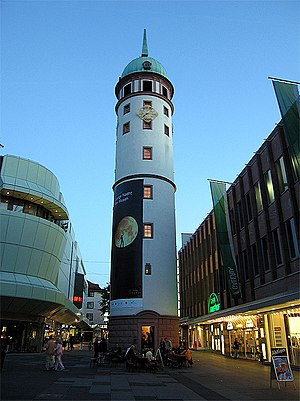Darmstadt correctional facility
 White Tower in Darmstadt (September 2007) |
|
| Information about the institution | |
|---|---|
| Surname | Darmstadt correctional facility |
| Reference year | 1969 |
The Darmstadt correctional facility in Darmstadt is the largest prison in southern Hesse . It serves the execution of prison sentences of up to two years for adult men. The penal institution is also known as the Fritz Bauer House and thus bears the name of the former State Attorney General of Hesse, Fritz Bauer (1903–1968). The higher-level authority is the Ministry of Justice of the State of Hesse .
history
The history of the penal system in Darmstadt as the capital of an independent territory has a long tradition. Originally the Round Tower and the White Tower , both parts of the medieval city fortifications, were set up as prisons. In 1721, the court architect of the Landgrave of Hesse-Darmstadt Louis Remy de la Fosse (1659–1726) was commissioned to expand the prison in the round tower by adding a two-story extension. In 1832 the city tower and the prison were demolished because the facilities no longer met the structural, safety and sanitary requirements that were aimed for.
A regional court prison, which was rebuilt from 1832 to 1834 under the senior building director Georg Moller (1784-1852) and which was subsequently expanded, replaced the old buildings. Immediately after the opening of the detention center, the political prisoners of the Grand Duchy, the participants in the Frankfurt Wachensturm and the “ Landbote” revolutionaries of the years 1833/34, were moved to the new house and newly arrested persons were locked up here. Pastor Friedrich Ludwig Weidig , a colleague of Georg Büchner , committed suicide while in Darmstadt in 1837.
In 1939 the Darmstadt Gestapo prison was relocated from Riedeselstrasse to the north wing of the district court prison in Rundeturmstrasse. Numerous opponents of the Nazi regime were brought there, tortured and executed. After the beginning of the Second World War , foreigners from 34 nations who were employed as slave labor in Darmstadt companies and who were accused of criminal offenses were also accommodated . The largest group was made up of prisoners from Poland (716 people) and the Soviet Union (437 people). 147 people came from France.
present
In the mid-1960s, planning began for a new correctional facility in Darmstadt, which the Ministry of Justice commissioned. Fritz Bauer campaigned for an inner-city high-rise prison based on the model of a nine-story prison in the New York borough of Brooklyn , but could not prevail with his ideas. Instead, the new Darmstadt JVA was built “as a modern model institution” outside the city, in the Darmstadt-Eberstadt district , not far from the Pfungstädter gallows , and inaugurated in 1969. The old institution was demolished and is now the location of a Fraunhofer Institute and a building of the TU Darmstadt . A wall still reminds of the old prison.
The Darmstadt correctional facility is also known to a broader public because a marathon competition has been held here on one lap within the prison premises since 2007 .
literature
- Werner Wendeberg: Darmstadt Prisons: Architecture and Ideology - Location decisions and construction of the prisons in Darmstadt as a reflection of attitudes towards crime and the penal system , self-published by the author, 2005 (Wendeberg was a Protestant pastor in the correctional facility)
- Thomas Michael Mayer: Georg Büchner: Life, Work, Time , Jonas, 1986, ISBN 978-3-92256148-4
- Susanne Lehmann (Red.), Georg Büchner: Revolutionary, poet, scientist 1813-1837 , exhibition Mathildenhöhe, Darmstadt, August 2 - September 27, 1987, Stroemfeld / Roter-Stern, Basel, Frankfurt am Main, 1987 ISBN 3-87877 -279-3 , p. 201
- Marie Frölich, Hans-Günther Sperlich: Georg Moller, Baumeister der Romantik , E. Roether, 1959, p. 181 ff.
See also
Individual evidence
- ^ "Darmstadt, Gestapo prison". Topography of National Socialism in Hesse. In: Landesgeschichtliches Informationssystem Hessen (LAGIS).
Web links
Coordinates: 49 ° 49 ′ 12.9 ″ N , 8 ° 37 ′ 20.6 ″ E